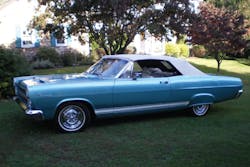Michael Phillips has had his head under the hood of a car for going on 50 years now; “I’ve been a motor head since I was a kid back in the ’60s,” he says.
In fact, Phillips, who is second-in-command at Classic Coachwork, a collision repair shop in Fort Washington, Penn., has a theory about baby boomers’ attachment to cars. He says a teenager is like the chicken that hatches from the egg and sees a dog first, latching on to the dog instead of its mother.
“When a 16-year-old kid sees a car, it has that same effect,” he says. “He latches on to the car and that’s the one he wants.”
Phillip’s object of affection was the Mercury Comet Cyclone convertible, which just happened to be release_notesd in 1966, the same year he turned 16. “I’ve been lusting after them ever since,” Phillips says.
While running his own shop in Pipersville, Penn., in the 1980s, one of Phillips’ employees purchased a 1966 Cyclone and started a restoration process, which wasn’t finished before the car traded hands among several employees. Phillips ultimately bought the car in the early ’90s, but by then it was in rough shape, with a tattered roof and flat tires.
“When I brought it home, my wife thought I was crazy,” he says.
Luckily for Phillips, the car’s previous owners had scoured flea markets for new and stock parts, which stayed with the car.
“I came to find out later that Mercury parts are unique and aren’t easy to find,” he says.
While not a complete rotisserie restoration, Phillips says the work he did on the car is as close to that type of restoration as you can get. He started by fixing the minimal rust damage, welding in patch panels where needed. Next, he replaced nearly all of the components that showed signs of wear and tear. This included the suspension system, exhaust, and the entire brake system.
He then sandblasted and epoxy-primed the vehicle, using a color key primer in the same turquoise color as the refinish. That way, “if the car gets a chip, it won’t show an odd color primer,” he says. After a lot of block sanding, he painted the car a vibrant turquoise. Phillips used Sikkens refinishing products, which he says have held up remarkably well since the paint job 12 years ago.
While Phillips was able to do nearly all of the restoration by himself in his garage, he did hire someone to reupholster the white top and re-cover the seats.
“The inserts of the seats are unique because they’re heat-embossed,” he says. “Those had to be maintained because you can’t get them anywhere.”
The only concessions to modern parts are the tires, which are radial tires instead of the original bias-ply. Though he gets points taken off when he takes the car to shows, he says he’d rather drive on tires that handle well.
The vehicle had only amassed 36,000 miles when he got it, which Phillips says could explain why the 289ci engine, topped with a four-barrel Holley carb, was in such good shape. Phillips says he decided against upgrading to a bigger engine.
“It’s not meant to be a speed demon,” he says. “It’s powerful enough for the kind of cruising that I do with it.”
All in all, the restoration took five years, with Phillips working on the car in his spare time. The Cyclone is now a “garage queen” in the winter, but during the warmer months, Phillips takes it out for cruise nights and shows, where it has won several awards. While Phillips sees a lot of the Cyclone’s cousin, the Ford Fairlane, he says the Cyclone convertibles, of which only 1,400 were produced, are more rare.
“It takes me back to when I was 16,” he says. “It’s archaic, but it always gets a lot of looks when I drive it.”
